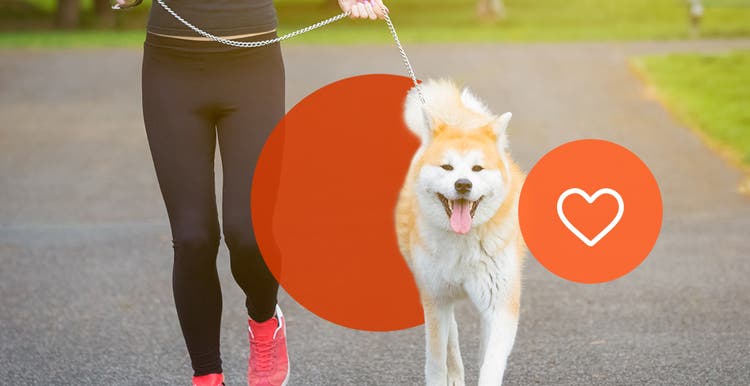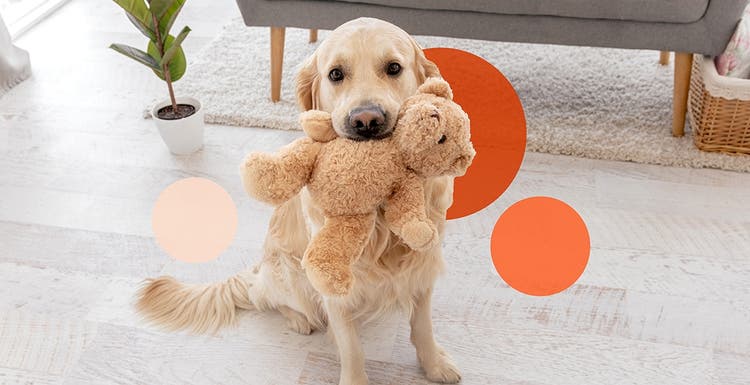Keep your dog active when you’re stuck inside.
Cold or rainy weather doesn’t pair well with trips to the dog park or long walks. But your dog still needs physical and mental exercise, both to stay healthy and to prevent boredom.
Discover ways to provide indoor exercise for your dog that will help them stay fit when they’re stuck inside.
Why Indoor Exercise for Dogs Is Important
Just like humans, dogs require exercise to stay fit and healthy, regardless of the weather. Without adequate exercise, dogs are at risk of becoming overweight, which can lead to health issues including joint problems, heart disease and respiratory issues.
Mental exercise for dogs is also an important aspect of daily dog care. Bored dogs tend to be unhappy dogs. And they will often look for ways to alleviate their boredom, including destructive and unruly behavior.
Indoor Exercises for Dogs
The best way to exercise your dog indoors depends on their size, age and health, as well as the amount of space you have available.
Indoor Exercises for Puppies and Small Dogs
- Have a wrestling match: Get on the floor and play with your pup like you’re another dog. But be gentle — and monitor their body language, stopping if they become overstimulated or show signs of getting tired.
- Play tug-of-war: Hold on tightly to your dog’s favorite toy while they try to pull it away from you. Hold the toy low enough that your dog doesn’t have to raise up or bend their neck backward, and be careful not to jerk the toy, which could hurt their tiny teeth. It’s also a good idea to let your dog win once in a while so they don’t grow bored with the game too quickly.
- Play fetch: If you have a long hallway or a large enough living room, throw your dog’s favorite toy and let them chase it. Use treats to encourage them to bring the toy back to you; otherwise your game of fetch could turn into a game of keep-away or chase instead.
- Practice obedience training: Give your dog some mental exercise by working on their manners and obedience skills. Walk them around the living room while you work on heeling or teach them to come when you call their name. Time spent practicing not only reinforces your dog’s training, but is also a great way to provide mental stimulation.
Indoor Exercises for Medium and Large Dogs
- Run up and down the hallway: Encourage your dog to accompany you as you jog up and down the hallway. This is a great form of exercise for healthy dogs with no joint problems.
- Hunt for hidden treasure: Hide treats around the house and encourage your dog to search for them to help stimulate their curiosity and give them a mental workout.
- Create an obstacle course: Using old boxes, couch cushions, blankets or whatever else you have on hand, set up an agility course in your living room or hallway and lead your dog through it.
- Walk on a treadmill: You can purchase a treadmill for dogs, which has safety rails on each side to prevent them from falling off. First, have your dog stand on the treadmill while it’s stationary. Feed them treats from the front of the treadmill to encourage them to stay on it. When they seem comfortable, start the treadmill at the lowest speed, continuing to feed treats to encourage them to move forward. Gradually increase the speed, one level at a time, until they reach a comfortable walking pace. When their walk is finished, slow the treadmill gradually to prevent accidents.
Indoor Exercises for Senior Dogs
- Try “doga”: Short for dog yoga, doga incorporates your dog into your yoga routine or helps your dog through a series of stretches and range-of-motion exercises. Doga can help increase flexibility, strengthen joints and improve your dog’s sense of well-being. It’s always good to check with your vet before starting doga, because you don’t want to put your senior dog in compromising positions that could stress joints.
Mental Exercises for Dogs
- Provide food-dispensing puzzle toys: Your dog thinks they’re getting a treat, but you know they’re getting a mental workout as they figure out how to access the food inside. Give them a store-bought puzzle toy, or make a simple DIY version by placing kibble inside an upside-down muffin tin.
- Teach your dog a new trick: Learning tricks is a great form of mental stimulation for dogs. Start with the basics, like “sit,” “stay,” “down” and “come,” and then branch out to more advanced tricks like “paw” or “shake,” “roll over” or “speak.”
- Teach your dog the names of their toys: Repeat the name of the toy every time you show it to your dog or interact with it. Once they make the connection, place different toys around the room and have your dog practice retrieving them by name.
You don’t necessarily need a lot of space to provide physical and mental exercises for dogs indoors, regardless of their size. Taking the time to engage with your dog in any of these activities can help them stay fit and happy during the cold and wet seasons.








